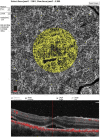Multifactor analysis of delayed absorption of subretinal fluid after scleral buckling surgery
- PMID: 33588767
- PMCID: PMC7885473
- DOI: 10.1186/s12886-021-01853-2
Multifactor analysis of delayed absorption of subretinal fluid after scleral buckling surgery
Abstract
Background: The purpose of this study is to assess the absorption of subretinal fluid (SRF) after scleral buckling (SB) surgery for the treatment of rhegmatogenous retinal detachment (RRD). We also examined related factors that may affect the delayed absorption of SRF.
Methods: This retrospective study included patients who underwent successful SB surgery for the treatment of macula-off RRD and in which the retina was reattached after the surgery. The patients were categorized according to gender, duration, age, the number, and location of retinal breaks. Subfoveal choroidal thickness (SFCT), height of subretinal fluid (SRFH), and the choriocapillaris flow density (CCFD) within 3 × 3 mm macular fovea were included. Delayed absorption was determined by the SRF that remained unabsorbed for 3 months after the procedure. The endpoint was determined when the SRF could no longer be observed.
Results: A total of 62 patients (63 eyes) were enrolled. In 35 eyes (56.45%) SRF was completely absorbed and in 28 (43.55%) eyes delayed absorption of SRF in macular areas was observed at 3 months after surgery. A young age (< 35 years), inferior retinal breaks were associated with good outcomes by applying multivariable analysis on the rate of SRF absorption after SB instead of gender, the number of breaks, and duration (p < 0.05). CCFD was significantly different between the SRF group and the non-SRF group after SB (0.66 ± 0.04% vs 0.63 ± 0.05%, P < 0.05). SRFH showed a moderate positive correlation with SFCT (rs = 0.462, p = 0.000), however, using binary logistic regression analysis it was determined that SFCT was not related to the absorption of the SRF.
Conclusions: The absorption of SRF after SB may be correlated with choriocapillaris flow density. Age and location of breaks are significant factors affecting the absorption of SRF. The duration of disease is an uncertain factor due to several subjective reasons.
Keywords: Choriocapillaris flow density; Optical coherence tomography; Optical coherence tomography angiography; Rhegmatogenous retinal detachment; Scleral buckling; Subretinal fluid.
Conflict of interest statement
The authors declare that they have no competing interests.
Figures



Similar articles
-
Effect of High Myopia on Delayed Absorption of Subretinal Fluid after Scleral Buckling Surgery.J Clin Med. 2022 Jul 5;11(13):3906. doi: 10.3390/jcm11133906. J Clin Med. 2022. PMID: 35807191 Free PMC article.
-
Spectral-domain optical coherence tomography analysis of persistent subretinal fluid after scleral buckling surgery for macula-off retinal detachment.Eye (Lond). 2015 Sep;29(9):1186-93. doi: 10.1038/eye.2015.113. Epub 2015 Jul 3. Eye (Lond). 2015. PMID: 26139048 Free PMC article.
-
[Multimodal Approaches for the Analysis of Retinal Functional Disorders―Focusing on Retinal Detachment].Nippon Ganka Gakkai Zasshi. 2017 Mar;121(3):185-231. Nippon Ganka Gakkai Zasshi. 2017. PMID: 30088405 Japanese.
-
A systematic review on delayed absorption of subretinal fluid after scleral buckling for rhegmatogenous retinal detachment.J Biol Regul Homeost Agents. 2017 Jul-Sep,;31(3):639-643. J Biol Regul Homeost Agents. 2017. PMID: 28954453
-
Persistent subretinal fluid after surgery for rhegmatogenous retinal detachment: hypothesis and review.Graefes Arch Clin Exp Ophthalmol. 2012 Jun;250(6):795-802. doi: 10.1007/s00417-011-1870-y. Epub 2012 Jan 11. Graefes Arch Clin Exp Ophthalmol. 2012. PMID: 22234351 Review.
Cited by
-
Effect of High Myopia on Delayed Absorption of Subretinal Fluid after Scleral Buckling Surgery.J Clin Med. 2022 Jul 5;11(13):3906. doi: 10.3390/jcm11133906. J Clin Med. 2022. PMID: 35807191 Free PMC article.
-
How should we report the foveal status in eyes with "macula-off" retinal detachment?Eye (Lond). 2023 Feb;37(2):228-234. doi: 10.1038/s41433-022-02074-7. Epub 2022 May 3. Eye (Lond). 2023. PMID: 35505112 Free PMC article. Review.
-
Clinical Analysis of Persistent Subretinal Fluid after Pars Plana Vitrectomy in Macula with Diabetic Tractional Retinal Detachment.J Clin Med. 2021 Dec 17;10(24):5929. doi: 10.3390/jcm10245929. J Clin Med. 2021. PMID: 34945225 Free PMC article.
-
Safety and efficacy of subthreshold micropulse yellow laser for persistent subretinal fluid after scleral bucking a randomized clinical trial.Sci Rep. 2024 Sep 6;14(1):20874. doi: 10.1038/s41598-024-71528-7. Sci Rep. 2024. PMID: 39242655 Free PMC article. Clinical Trial.
-
Effect of external subretinal fluid drainage on persistent subretinal fluid after scleral buckle surgery in macula-involving rhegmatogenous retinal detachment.Sci Rep. 2023 Dec 13;13(1):22176. doi: 10.1038/s41598-023-49719-5. Sci Rep. 2023. PMID: 38093092 Free PMC article.
References
MeSH terms
LinkOut - more resources
Full Text Sources
Other Literature Sources
Medical
Miscellaneous

